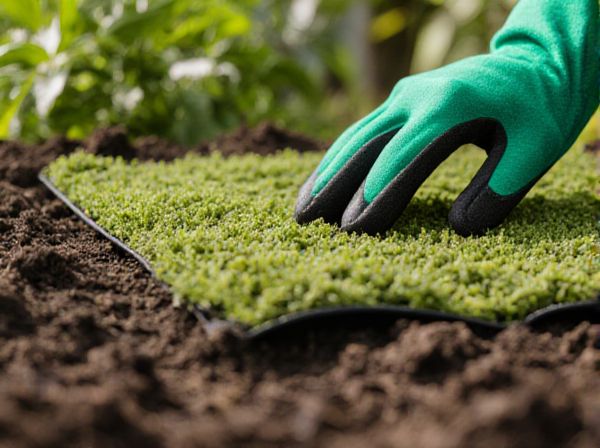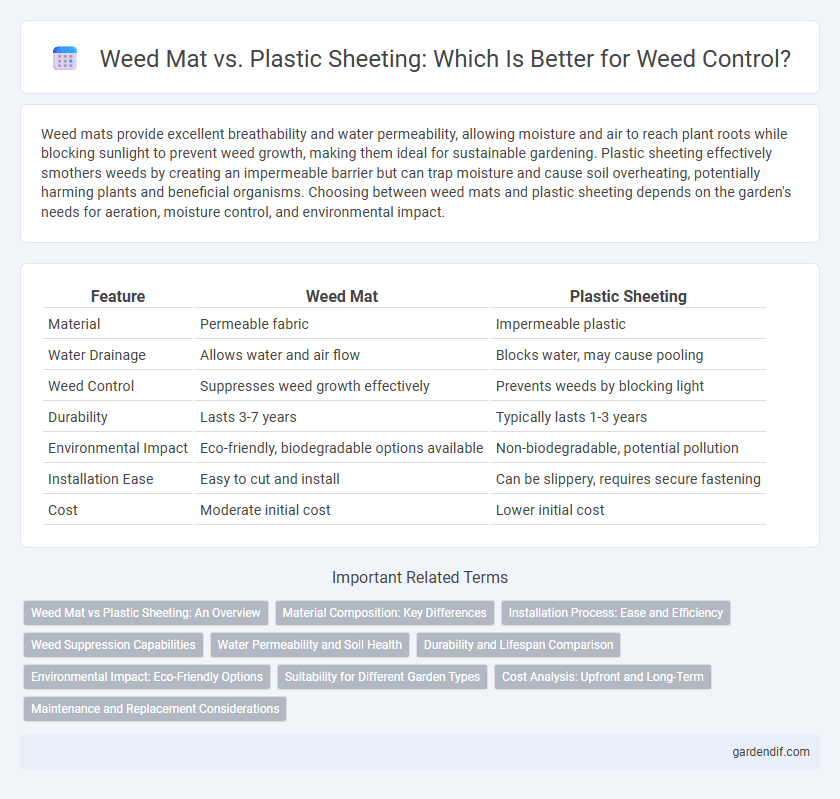
Weed mat vs Plastic sheeting Illustration
Weed mats provide excellent breathability and water permeability, allowing moisture and air to reach plant roots while blocking sunlight to prevent weed growth, making them ideal for sustainable gardening. Plastic sheeting effectively smothers weeds by creating an impermeable barrier but can trap moisture and cause soil overheating, potentially harming plants and beneficial organisms. Choosing between weed mats and plastic sheeting depends on the garden's needs for aeration, moisture control, and environmental impact.
Table of Comparison
| Feature | Weed Mat | Plastic Sheeting |
|---|---|---|
| Material | Permeable fabric | Impermeable plastic |
| Water Drainage | Allows water and air flow | Blocks water, may cause pooling |
| Weed Control | Suppresses weed growth effectively | Prevents weeds by blocking light |
| Durability | Lasts 3-7 years | Typically lasts 1-3 years |
| Environmental Impact | Eco-friendly, biodegradable options available | Non-biodegradable, potential pollution |
| Installation Ease | Easy to cut and install | Can be slippery, requires secure fastening |
| Cost | Moderate initial cost | Lower initial cost |
Weed Mat vs Plastic Sheeting: An Overview
Weed mats offer breathable, permeable fabric that allows water and air to reach plant roots while effectively suppressing weed growth, making them ideal for sustainable gardening. Plastic sheeting provides a durable, impermeable barrier that blocks light entirely, preventing weeds but potentially causing soil moisture issues and poor aeration. Both materials serve as weed control solutions, with weed mats favoring plant health through soil breathability and plastic sheeting maximizing weed suppression with a heavier environmental impact.
Material Composition: Key Differences
Weed mats are typically made from woven or non-woven polypropylene fibers designed to allow air, water, and nutrients to pass through while suppressing weed growth. Plastic sheeting is usually composed of polyethylene, creating a solid barrier that blocks light and moisture but can lead to soil overheating and poor aeration. The material composition of weed mats promotes healthier soil conditions compared to the impermeable, heat-retentive nature of plastic sheeting.
Installation Process: Ease and Efficiency
Weed mats offer a straightforward installation process by simply laying the fabric over the soil and securing it with pins, which allows water and air to reach plant roots while preventing weed growth. Plastic sheeting requires precise overlapping to avoid gaps, but its smooth surface can be more difficult to anchor, often necessitating additional tools or weights to prevent displacement. Overall, weed mats provide greater ease and efficiency in installation with less risk of tearing compared to plastic sheeting.
Weed Suppression Capabilities
Weed mats provide superior weed suppression by allowing water and air to penetrate while blocking sunlight essential for weed growth, promoting healthier plants without chemical herbicides. Plastic sheeting effectively blocks all sunlight, preventing weed germination, but can cause water runoff and soil suffocation, potentially harming desirable plants. Choosing between weed mats and plastic sheeting depends on balancing breathability and durability against total weed exclusion.
Water Permeability and Soil Health
Weed mats offer superior water permeability compared to plastic sheeting, allowing rainwater and irrigation to pass through while suppressing weeds, which helps maintain soil moisture levels essential for plant growth. Unlike plastic sheeting that creates a barrier leading to water runoff and potential soil compaction, weed mats promote healthier soil aeration and microbial activity by facilitating gas exchange. This improved water flow and soil health contribute to sustainable gardening practices and enhanced plant vitality.
Durability and Lifespan Comparison
Weed mats typically offer superior durability compared to plastic sheeting due to their woven polypropylene fabric, which resists tearing, UV degradation, and allows for water permeability. Plastic sheeting, while initially effective as a weed barrier, tends to degrade faster under sunlight exposure and may crack or become brittle, significantly shortening its lifespan. Overall, weed mats provide a longer-lasting, more robust solution for weed control in gardens and landscaping projects.
Environmental Impact: Eco-Friendly Options
Weed mats, made from biodegradable materials, offer a sustainable alternative to plastic sheeting by reducing soil pollution and promoting healthier ecosystems. Unlike plastic sheeting, which can contribute to long-lasting environmental waste and microplastic contamination, weed mats break down naturally, minimizing landfill accumulation. Choosing eco-friendly weed control solutions supports biodiversity and decreases the carbon footprint associated with synthetic materials.
Suitability for Different Garden Types
Weed mats provide excellent breathability and water permeability, making them ideal for flower beds, vegetable gardens, and areas requiring soil aeration. Plastic sheeting offers superior moisture retention and weed suppression, suitable for pathways, driveways, and non-vegetated zones. Selecting the appropriate material depends on garden type, soil needs, and plant growth requirements.
Cost Analysis: Upfront and Long-Term
Weed mats typically involve a higher initial investment than plastic sheeting due to durable woven materials designed for longevity and effectiveness in weed control. Over time, weed mats offer cost savings by reducing the need for frequent replacement, minimizing labor costs related to weed removal, and improving plant growth through better soil aeration. In contrast, plastic sheeting, while cheaper upfront, often requires maintenance or replacement due to tearing and degradation, leading to higher long-term expenses.
Maintenance and Replacement Considerations
Weed mats require periodic maintenance such as repositioning and occasional replacements every 3 to 5 years due to natural wear and UV degradation. Plastic sheeting, while more durable and less prone to tearing, can become brittle over time and typically needs replacing every 5 to 7 years depending on environmental exposure. Both materials demand monitoring for damage to ensure effective weed suppression and prevent plant growth through tears or gaps.
Weed mat vs Plastic sheeting Infographic

 gardendif.com
gardendif.com